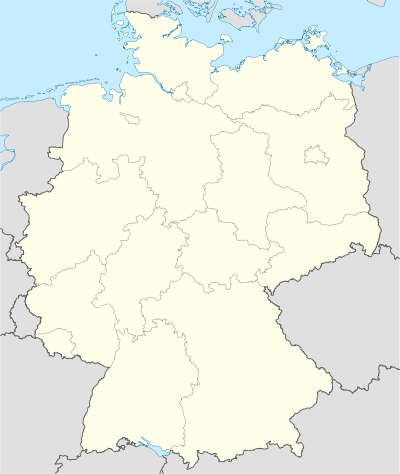Schwerin
| Schwerin | |
 |
|
 |
|
 Schwerin
|
|
| Coordinates | |
| Administration | |
| Country | Germany |
|---|---|
| State | Mecklenburg-Vorpommern |
| District | Urban district |
| Town subdivisions | 18 boroughs |
| Lord Mayor | Angelika Gramkow (Die Linke) |
| Basic statistics | |
| Area | 130.46 km2 (50.37 sq mi) |
| Elevation | 38 m (125 ft) |
| Population | 95,041 (31 December 2009)[1] |
| - Density | 729 /km2 (1,887 /sq mi) |
| Other information | |
| Time zone | CET/CEST (UTC+1/+2) |
| Licence plate | SN |
| Postal codes | 19053, 19055, 19057, 19059, 19061, 19063 |
| Area code | 0385 |
| Website | schwerin.de |
|
|||||||||||||||||||||||||||||
|
|||||||||||||||||||||
Schwerin (German pronunciation: [ʃveˈʁiːn]) is the capital and second-largest city of the northern German state of Mecklenburg-Vorpommern. The population, as of end of 2007, was 95,855.
Contents |
History
Schwerin is surrounded by many picturesque lakes. The largest of these lakes, the Schweriner See, has an area of 60 km². In the midst of these lakes there was once an Obotrite settlement (dated back to the 11th century). The area was called Zuarin, and the name Schwerin is derived from that designation. In 1160, Henry the Lion defeated the Obotrites and captured Schwerin. The town was subsequently expanded into a powerful regional centre. A castle was built, and expanded upon over the centuries, on this site. It is supposedly haunted by the small, impious ghost, called Petermännchen.
In 1358, Schwerin became a part of the Duchy of Mecklenburg, making it the seat of the dukedom from then on. About 1500, the construction of the Schwerin castle began; it was here that the dukes resided. After the division of Mecklenburg (1621), Schwerin became the capital of the Duchy of Mecklenburg-Schwerin. Between 1765 and 1837, the town of Ludwigslust served as the capital, until Schwerin was reinstated.
After 1918, and during the German Revolution, resulting in the fall of all the German monarchies, the Grand Duke abdicated. Schwerin became capital of the Free State of Mecklenburg-Vorpommern thereafter.
At the end of World War II, on 2 May 1945, Schwerin was taken by U.S. troops. It was turned over to the British on 1 June 1945, and one month later, on 1 July 1945, it was handed over to the Soviet forces, as the British and American forces pulled back from the line of contact to the predesignated occupation zones. Schwerin was then in the Russian Occupation Zone which was to become the German Democratic Republic (GDR). Initially, it was the capital of the State of Mecklenburg which at that time included the western part of Pomerania (Vorpommern). After the states were dissolved in the GDR, in 1952, Schwerin served as the capital of the Schwerin district (Bezirk Schwerin).
After reunification in 1990, the former state of Mecklenburg-Vorpommern was recreated as one of the Bundesländer. Rostock was a serious contender as state capital but the decision favored Schwerin.
Transport
City buses and trams are run by NVS (Nahverkehr Schwerin).
Main sights
- The landmark of the city is the Schwerin Castle, located on an island in the lake of the same name (Schweriner See). It was, for centuries, the residence of the Dukes of Mecklenburg and today is the seat of the Landtag (state parliament).
- Schwerin Cathedral, built in 1260–1416 in Brick Gothic style.
- The Alter Garten (Old Garden) square, surrounded by buildings such as the 18th-century Altes Palais (Old Palace), the neoclassical Staatliches Museum Schwerin (State Art Museum), built in 1877–1882, and the Staatstheater (City Theater), erected in 1886.
- The town hall (18th century)
- Schelfkirche (Saint Nicolai, originally built 1238, but rebuilt in 1713 after destruction by a storm)
- Television mast Schwerin-Zippendorf

Museums
- The Staatliches Museum Schwerin-Kunstsammlungen (State Art Museum) houses a remarkable collection of Dutch paintigs from 16th centuries Dutch painter scools German art from medieval and renaissance masters til now. There are also an exqisite collektion of Greak vases, the wearld-wide importendst collektion of Paintings of Jean-Baptiste Oudry, a remarcable collektion of sculptures of Houdon, German 18th-century court paintings, and works by such modern artists as Max Liebermann, Franz Stuck, Marcel Duchamp etc. The Graphic cabinet houses rich collections of Duch and German drawings and prints (Jan van Goyen, Dürer, Cranach, Rembrand, Merian etc.) and the world-wide best collection of coloured graphics from the time of the GDR.
- The Technische Museum (Technical Museum), housed in the former Marstall (Royal Stables).
Gallery
 Schwerin Castle |
 Pfaffenteich and the Schwerin Cathedral |
 Aerial view of Schwerin |
 Coat of arms, 1939–91 |
 St. Paul's church |
 Fridericianeum |
 Former power station |
 State museum |
References
- ↑ "Bevölkerungsentwicklung der Kreise und Gemeinden" (in German). Statistisches Amt Mecklenburg-Vorpommern. 31 December 2009. http://service.mvnet.de/statmv/daten_stam_berichte/e-bibointerth01/bevoelkerung--haushalte--familien--flaeche/a-i__/a123__/2009/daten/a123-2009-22.pdf.
External links
- City's official website (German)
- Tram in Schwerin
- Schwerin website (school project) (English)
|
||||||||||
|
|||||||
|
|||||||||||||||||
